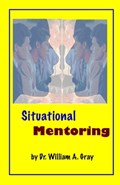Why should you read Situational Mentoring™? You will learn what over 100,000 mentors and proteges have learned: How to employ four Mentoring Styles in a flexible manner – so mentors equip proteges with what they know (wisdom, practical know-how, etc.) and empower what proteges want to do and become. Situational Mentoring™ prevents “getting stuck” overly using a Preferred Mentoring Style – which causes mentoring relationships to fall apart so goals are not met.
Book purchasers can receive a free copy of the Mentoring Style Indicator by contacting Dr. Gray.
Since 1978, different kinds of proteges have benefited from Situational Mentoring: youth in grades 4-12, college students, new teachers and principals, new hires in corporate and government situations, as well as proteges needing guidance for career development and for becoming leaders.
Chapter 1: Why Situational Mentoring? describes the negative consequences of “getting stuck” overly using a Preferred mentoring Style – and how to prevent this.
Chapter 2: Equipping + Empowering => Successful Protégé describes the importance of equipping protégés with what mentors know and empowering what protégés want to do and become, and how this can have a transformational impact on the protégé and the organization.
Chapter 3: Mentoring with the Right Style provides a Situation from one of the 11 versions of my Mentoring Style Indicator, then describes four Mentoring Styles and 26 mentoring behaviors that equip and empower proteges.
Chapter 4: Mentoring for Results describes a 6-Step Mentoring Process™ to equip and empower proteges to handle challenging situations. Such as: solving a difficult problem, deciding what to do when facing a dilemma, transitioning to a different position or career.
Chapter 5: Applying Situational Mentoring provides a transcript of a mentor helping a protege make a major career change, by progressing from being Unconsciously Incompetent (“I don’t have a clue what to do”) to become Consciously Competent (aware of what to do and able to do it).
Chapter 6: How Proteges Can Manage Situational Mentoring describes how I guided my first business mentor through my 6-Step Mentoring Process so he could help me transition from being a salaried professor to become an entrepreneur generating my own income.
Chapter 7: Mentor-Assisted Enrichment Projects Enhance STEM Education describes my most significant application of Situational Mentoring over an eight year period when I was a professor – and gave my undergrads course credit for carrying out projects with small groups of protégés (grades 4-12), which focused on an important aspect of Science, Technology, Engineering, Mathematics (STEM).

